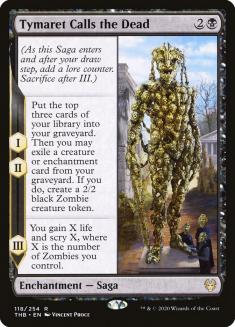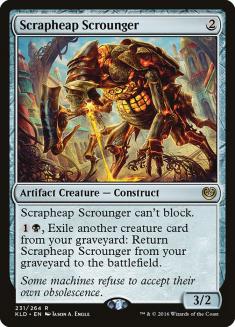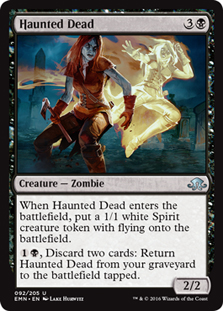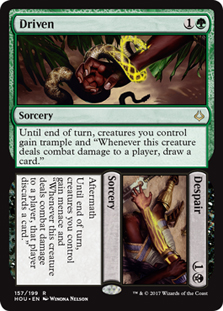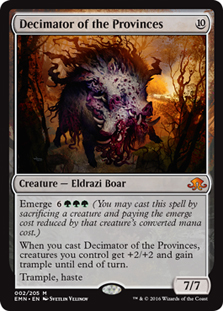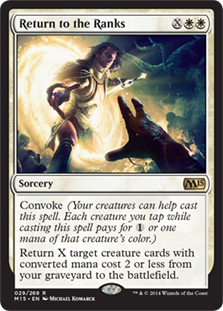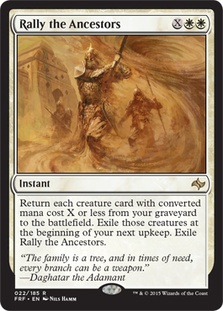Christmas may have passed for the rest of the world, but it continues into January for Magic players, with the beginning of another preview season. Theros Beyond Death is the first new set we’ll see since the launch of Pioneer, thus marking the first influx of cards for Magic’s newest and, dare I say, most popular format.
The promise of new toys should also bring renewed interest to a Standard format that has suffered under the duopoly of Field of the Dead and Oko, Thief of Crowns for months. Interest in the format hasn’t rebounded as much as hoped since those cards were banned, despite the format looking its most healthy and interesting since the spring.
The early preview season is mostly about finding cards that bolster existing archetypes, and I see an obvious winner on that metric in Tymaret Calls the Dead.
The first good sign is that the card reads similarly to History of Benalia, which saw lots of play in its time in Standard and has snuck into Pioneer as well. It’s clear that paying three mana for two 2/2 creatures with some marginal upside is a fine rate, but the two cards differ in an important way. Tymaret Calls the Dead does not guarantee that you get the Zombie tokens, requiring that you have a creature or enchantment in your graveyard to exile.
That makes Tymaret Calls the Dead weaker automatically, since the fail case is a significant downside, and you’ll want to fill your deck with enough creatures and enchantments to mitigate that downside. Twenty is the bare minimum I’d play with, but even that only gives you a 71.1% chance to hit. You’ll need to go up to 25 hits to increase those odds to 80%, and 32 to get up to 90%. That’s a real hoop to jump through, but not insurmountable.
In order to want to jump through the hoop, you’ll need a real incentive. That incentive is obvious here: Tymaret Calls the Dead is a graveyard enabler. Milling six cards, even if you have to exile two right off the bat, is a great set-up piece for any deck trying to generate value from its graveyard. These sorts of decks also tend to play lots of other Zombies, since it’s the tribe that plays the most from the graveyard, so the synergies you enable with the Saga get further paid off in the third chapter.
That last bit of synergy isn’t much on the surface, but when you can get a card that functions as both enabler and payoff, you start to supercharge the engine, so it won’t take much to put an already competitive graveyard deck over the edge. It’s also important to note that Tymaret Calls the Dead plays well in decks with other graveyard enablers, since the cost to get a token is not restricted to the three cards milled by the trigger, so you can be sure you’ll get a Zombie by filling your graveyard beforehand.
The last point in Tymaret Calls the Dead’s favor is that it’s an enabler which affects the battlefield. Most of the time you’re casting instants or sorceries that fill the graveyard, hoping to find an immediate payoff or you fall behind. Maybe you get a 1/1 in the deal with Stitcher’s Supplier or Satyr Wayfinder, and those are premium enablers as a result. Here you’re likely getting a pair of 2/2s, which is a real battlefield presence that can force a sweeper against control decks, play defense against aggro, or pressure opposing combo decks. Even if your mills aren’t great, you should have time to keep digging and find what you need.
I already liked the graveyard decks in Pioneer, as I wrote about earlier this month, and Tymaret Calls the Dead slots nicely into both Sultai Dredge and Zombie Rally:
Creatures (25)
- 4 Narcomoeba
- 4 Satyr Wayfinder
- 3 Gurmag Angler
- 4 Prized Amalgam
- 1 Decimator of the Provinces
- 3 Haunted Dead
- 2 Scrapheap Scrounger
- 4 Stitcher's Supplier
Lands (20)
Spells (15)
Sideboard

It’s tricky business finding space in a deck like this because you need to keep a tight ratio between the various elements: enablers, payoffs, lands, etc. But because Tymaret Calls the Dead functions as both an enabler and a payoff, it gives you a bit more leeway. You don’t need to recur as many creatures when you’re making a pair of Zombies, so the easiest trims are the creatures that cost mana to recur, and thus are weak in multiples. Thus I went down to two copies of Scrapheap Scrounger and three of Haunted Dead.
Beyond that, you want to cut noncreature cards to keep the count high enough to consistently make Zombies, and I think Gather the Pack is slightly worse than Grisly Salvage. The upsides on Gather are small, and while being an instant doesn’t look significant, it is in the sideboard games when you can hold up an answer to hate on Turn 2 and cast it or make a good proactive play, depending on what your opponent does. Trimming on Gathers leaves you with 29 hits for Tymaret Calls the Dead, and with the other enablers to prime the graveyard, you should have no problem getting full value from the card.
The third chapter’s scry ability also lets you find high-impact cards more readily, so Driven can become a singleton alongside the one copy of Decimator of the Provinces, which has become popular in the archetype over the last two weeks. Decimator, in particular, gets much better with Tymaret Calls the Dead, since it provides multiple bodies to pump and digs for the pig, the Gurmag Angler to enable emerge, or extra lands so you can cast it with Haunted Dead.
Since Tymaret Calls the Dead is particularly vulnerable to Leyline of the Void and Rest in Peace, I’ve skewed the sideboard to have extra answers to those cards, though the creature removal spells also let you clear out blockers for your Zombie horde.
Rally Zombies is a more interesting case. In my experience with the deck, the namesake card underperformed because it was difficult to fill your graveyard enough to utilize it. Emma Handy, who has been working on the deck, has taken to playing Return the Ranks and trimming on Rallys as a result:
However, the deck’s aggro plan is still quite strong, and Tymaret Calls the Dead is an excellent enabler, since it helps both that aggro plan and the Rally combo plan. The third chapter is incredible in a tribal shell, providing reach and helping you dig for a Rally should you need an even bigger turn. Notably, you can also Rally for two with the trigger on the stack to fill your battlefield, a pattern which the sorcery-speed Return to the Ranks can’t play.
I was on board with Emma on Rally being a trap, but with another excellent enabler, I have to give it another chance. Tymaret Calls the Dead even functions as multiple bodies to enable your other synergies, from drain effects to Cryptbreaker to Dark Salvation. Having to exile a Zombie to make the token is awkward with Rally, but you should still have an extra creature or two to return.
Creatures (25)
- 2 Nantuko Husk
- 2 Diregraf Colossus
- 4 Cryptbreaker
- 1 Dread Wanderer
- 4 Wayward Servant
- 4 Stitcher's Supplier
- 2 Lazotep Reaver
- 4 Corpse Knight
- 2 Foulmire Knight
Planeswalkers (2)
Lands (22)
Spells (11)
Sideboard

Like the Dredge deck, this list has 29 hits to make tokens by trimming on Liliana, Untouched by Death and Dark Salvation. That keeps the curve low enough to come out of the gate quickly, while the loss in late-game power is covered by Tymaret Calls the Dead scrying to dig for your more powerful effects.
I really want this deck to have that combo aspect since the creatures themselves are weak in combat. Your recursive threats and built-in card advantage help the deck against reactive strategies, but you don’t want to get in the red zone against the likes of Lovestruck Beast and Rekindling Phoenix, and combo decks should be able to race a pile of 2/2s. Return to the Ranks may be more consistent, but Rally is undoubtedly more powerful, so there’s incentive to make it work.
Thus far the Dredge deck has outperformed Zombie Rally, and I think the latter’s inability to consistently enable graveyard synergies is a big reason why. If Tymaret Calls the Dead proves powerful, it could flip the script on graveyard strategies in Pioneer.
Moving to Standard, there isn’t the same opportunity for heavy graveyard synergies, but the proven pair of Cauldron Familiar and Witch’s Oven should play nicely with a card that digs for your Cats and provides bodies to make Food. Jund Sacrifice is already jam-packed with other Food synergies, so I don’t want to pull it in another direction, but Rakdos Sacrifice would certainly welcome the card:
Creatures (23)
- 3 Midnight Reaper
- 2 Gutterbones
- 3 Priest of Forgotten Gods
- 2 Lazotep Reaver
- 4 Mayhem Devil
- 1 God-Eternal Bontu
- 2 Rankle, Master of Pranks
- 4 Cauldron Familiar
- 2 Woe Strider
Lands (24)
Spells (13)
Sideboard

Having another card that makes multiple bodies helps out Priest of Forgotten Gods, while the self-mill can also hit Gutterbones to generate free value. There are enough Zombies in the deck to take advantage of the third chapter, which is also why I included a singleton copy of God-Eternal Bontu to scry for.
The concern here is the glut at three in the curve, which is exacerbated by the inclusion of another Theros Beyond Death preview, Woe Strider, but the card reads too well to not try. It’s another sacrifice outlet, another valuable mill, and multiple bodies in one at a good rate.
The higher curve is somewhat mitigated by the improvements to the manabase made by being able to cut Chandra, Acolyte of Flame. The double-red three-drop always fit awkwardly, and playing Evolving Wilds next to Fabled Passage was only made bearable by the synergy with Mayhem Devil. Now you get to play more basic Swamps to make the mana smoother so you don’t stumble.
Trimming on Rankle, Master of Pranks helps keep the curve low, but mostly I had to cut cheap spells to keep the creature and enchantment count high enough, and at 27 it’s solid, yet borderline without other ways to fill the graveyard. Losing extra copies of Claim the Firstborn and Heartfire means less reach, but Chapter III of Tymaret Calls the Dead mitigates that while also contributing to the aggro plan. I’m more concerned with ensuring Priest of Forgotten Gods consistently does good things, since the downside of Squire is untenable.
There’s the potential for more graveyard-centric cards to be revealed as preview season continues, and if so, I could see Tymaret Calls the Dead in other shells. PVDDR looked at some Black Devotion lists with the return of Gray Merchant of Asphodel, which is both a Zombie and a high-impact card to scry towards on Turn 5 when an on-curve Saga will trigger its third chapter. But with the Saga itself offering only a small, temporary boost in devotion, I would need to see more graveyard or tribal synergies to bring it together.
As I noted earlier, Tymaret Calls the Dead is not History of Benalia. The card requires some effort in deckbuilding to make it work, while History has mostly been a set it and forget it threat that provides incidental tribal synergies. But Magic’s competitive history is littered with decks using their graveyard to create huge advantages in tempo and material. Because of that, there’s a huge upside to Tymaret Calls the Dead that History of Benalia could never touch. In Pioneer, the tools already exist to realize that upside and I’ll be following this preview season closely to see if similar tools come to Theros Beyond Death Standard as well.

